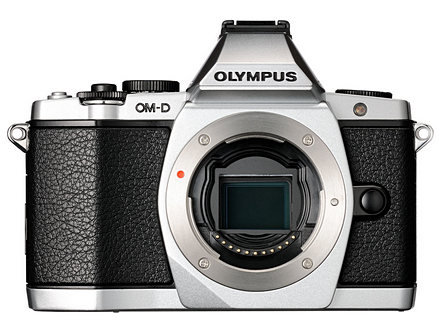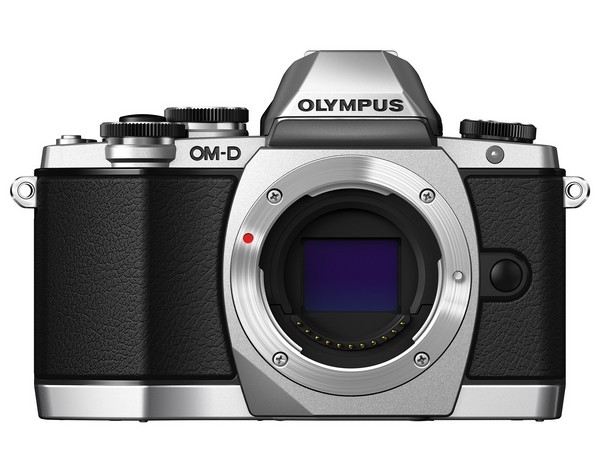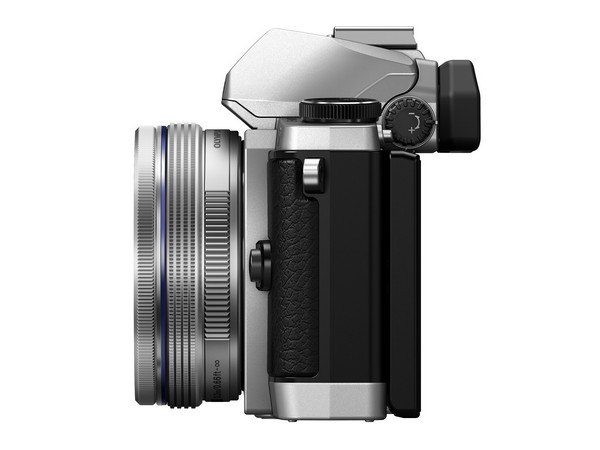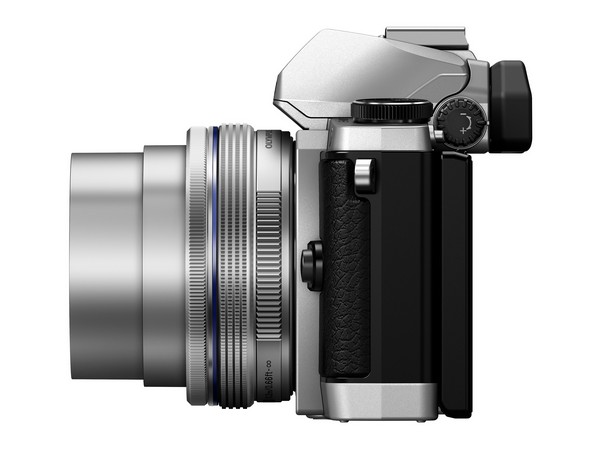
|
Olympus E-M10: Quick Notes |

|
My other articles related to the |
|
The classic SLR camera evolved over a few decades into the familiar shape: a horizontal box topped with the prism hump and two shoulders devoted to controls. This is how the first Exaktas looked, not much different than the late film SLRs from the beginning of this century, or the digital ones being made now. If a formfactor works ergonomically well (and looks good), it will often be used for constructions where it is no longer necessitated by the technical solutions used inside. This is how we arrived to dozens of models of "SLR-like" digital cameras, i.e. ones which do not have a viewing prism and therefore do not need the hump, but still have it, and people who buy and use cameras just like this shape for various reasons. The first such non-SLR cameras were "superzoom" models with wide-range, non-interchangeable zoom lenses. Then the design was adopted to interchangeable-lens cameras, with the Panasonic G1 (2008) being, if I'm not wrong, the first such model (and also the first one using the Micro Four Thirds mount/sensor standard, introduced jointly with Olympus). The first Olympus μFT models (from 2009 on), the Pen line, went another way, having adopted a brick shape, with the only viewing aid being the rear-side monitor (and the eye-level electronic viewfinder introduced a bit later as an add-on). Still, it was certain, especially after Olympus abandoned their Four Thirds SLR line that year, that an SLR-shaped μFT camera from Olympus will follow. It did. While the Pens were quite successful (especially, but not only, in Japan), the E-M5 of 2012 was the best-selling Olympus camera in years, and deservedly so. This was the beginning of the new Olympus model line, named OM-D. A year later, the E-M1 was released, to a most enthusiastic response of the photographing crowd — and that in spite of a relatively high price of $1400 (or $2400 with a pREMum standard-range F/2.8 zoom lens). Enter the E-M10. While the E-M5 is a very nice camera and provides most satisfactory results, the market demands a "new, improved" model every year, so we now have a replacement (?): the E-M10, available at $700 (body) or $800 (with the "old" 14-42 mm lens, see below). Actually, as some of the (less-essential) specs of the E-M10 have been downgraded from the E-M5, it is not clear if and for how long both models may coexist on the market, although I don't think this will happen. Note of 2017: I was wrong: the E-M10 became the entry-level camera in the OM-D family, with the E-M5 being the mid-line; this became even more clear when Mark II models of both were introduced. Enough introductions, now let's get down to a close look at the specs. As the new camera has big shoes to fill, comparisons with the E-M5 will be unavoidable. This is a small camera, a tad smaller than the E-M5. Look at the mug shots of both, to scale: |

Olympus E-M5 |

Olympus E-M10 |
|
According to the Olympus data, the size (W×H) of the E-M10 is 119×82 mm, compared to 122×89 mm for the E-M5.
While the difference between both seems obvious in the vertical dimension (mostly, but not only, due to shrinking the hump protrusion), there is something fishy in quoted camera widths (for this comparison I scaled both pictures so that the inner diameter of the lens mount, measured in pixels, is the same). Oh, well, I'm glad the difference is not larger, as this is probably the smallest system camera I can handle. The weight of the new model has also been reduced: from 425 to 396 g (including battery), or by about an ounce. The body grip remains mostly the same: if you liked the one in E-M5, you will like this one, and vice versa. It is adequate for use with smaller lenses, but not with heavier ones. Still, you can get used to it. There is one omission in the E-M10, which for some people may be a complete non-issue, but for others — a deal-breaker: no splash- of dust-proofing. While this is a feel-good feature, it costs extra money, so I'm not surprised Olympus dropped it from this model, priced 30% less that the E-M5 originally was. All camera's controls are grouped in two locations: the top deck and the rear side. The top deck remains almost exactly like the one in the E-M5. On the right side we find two control dials (one with the shutter release in the center) and two buttons.
|
|
Generally, external controls in the E-M10, while basically inherited from the E-M5, underwent some incremental (but welcome) improvements, and I think I can easily live with them (even if I like the E-M1 more from this angle).
The eye-level electronic viewfinder (EVF) in the E-M10 is the same as in the E-M5, or at least has identical specifications: 1.4 million dots (RGB sub-pixels) and a magnification of 0.575× (normalized to the full-frame film size; the nominal value is twice that, but it is not meaningful in comparisons). A few years ago this would be just great: the apparent image size is the same as in the E-3 or E-5 SLRs, significantly larger than in most other such cameras, Olympus or not. Still, the E-M1 beats that easily with 2.36 million dots and 0.74× (normalized), and so do some other recent upper-shelf cameras. Well, you cannot expect a camera to match one at twice the price; something has to give. Anyway, the finder is perfectly usable, and under most circumstances as good as (or better than) an SLR one in this price range, so no complaints here. Sorry to say, but the SLR is on its way out. And yes, you can choose from three various display layouts to suit your taste; nice. A button switch toggles the display between the EVF and monitor. There is also an eye-proximity switch activating or disabling the EVF and monitor as needed, depending if your eye (or some other body part) is close to the eyepiece. The logic works just fine in either display toggle position (this is not true for all cameras I've tried; don't take things for granted!). The 3-inch monitor has an improved resolution of 1.04 million dots, improved from the 0.61 million in the E-M5 (the difference is really visible only in direct comparison, I could easily live with the lower value). It tilts up and down, but does not swivel to the side. Actually, I prefer this as a simpler and more robust solution, which is also more compact in use. If requested, both the EVF and monitor may show a level gauge, which is more useful than it may seem at the first glance. I found this indispensable. Here is a list of the camera's features, most of them similar to those of the E-5. with any differences explicitly marked as such.
I think I've covered all specs, at least the important ones. If I discover something else, the article will be updated with a proper notice at the top, so that you do not have to read the whole thing again. After this walk-through I can say the E-M10 seems functionally identical to the well-proven E-M5 except for just a few points:
Therefore, with the image quality similar to that of the E-M5, and very nice build and finish, I consider the E-M10 to be a (slightly) better camera — unless you must have weather sealing. This may be not quite what Olympus intended, with the E-M10 clearly aimed at the lower end of the market, and with the middle (enthusiast amateur) segment served by the E-M5. In any case, in spite of growing competition in the ILC camera market (Panasonic, Sony, Fujifilm, to name just a few), I expect the E-M10 to become a hot seller. Appendix: The new "standard zoom" lens Thanks to the joint effort between Panasonic and Olympus, Micro Four Thirds cameras enjoy the widest lens selection in this (ILC) camera group. Both companies offer a nice range of high-quality, reasonably priced primes, and they keep adding new releases over the whole price spectrum. Here, however, I will focus on a new "standard zoom" lens released at thee same time as the E-M10 (and, at least on some markets, but not in the U.S., sold bundled with that camera). The new lens is the pancake zoom: M. Zuiko Digital ED 14-42 mm F/3.5-5.6 EZ.
|
| 
| 
|
| MZD ED 14-42 mm F/3.5-5.6 EZ, collapsed and extended, on the E-M10 body
|
This is a collapsible lens, one of the coolest I've seen: collapsed it protrudes just 22.5 mm (0.9") from the flange; it weighs 93 g (3.3 oz) and takes 37 mm filters, focusing down to 20 cm (at 42 mm). It has three aspherical elements and two made of special glass. Zooming is motor-driven, so it can be done remotely from a smartphone application. On top of all this, the lens looks very cute.
In the U.S. it is sold separately, to the tune of $300. If you want to get a bundled starter lens with your E-M10, this will be probably the 14-42 mm F/3.5-5.6 II R, also collapsible but less so, and also taking 37 mm filters. This one will add about $100 to the camera price, which is a bargain. | |||||

|
My other articles related to the |
| This page is not sponsored or endorsed by Olympus (or anyone else) and presents solely the views of the author. |
| Home: wrotniak.net | Search this site | Change font size |
| Posted 2014/01/30; last updated 2018/12/14 | Copyright © 2014 by J. Andrzej Wrotniak |